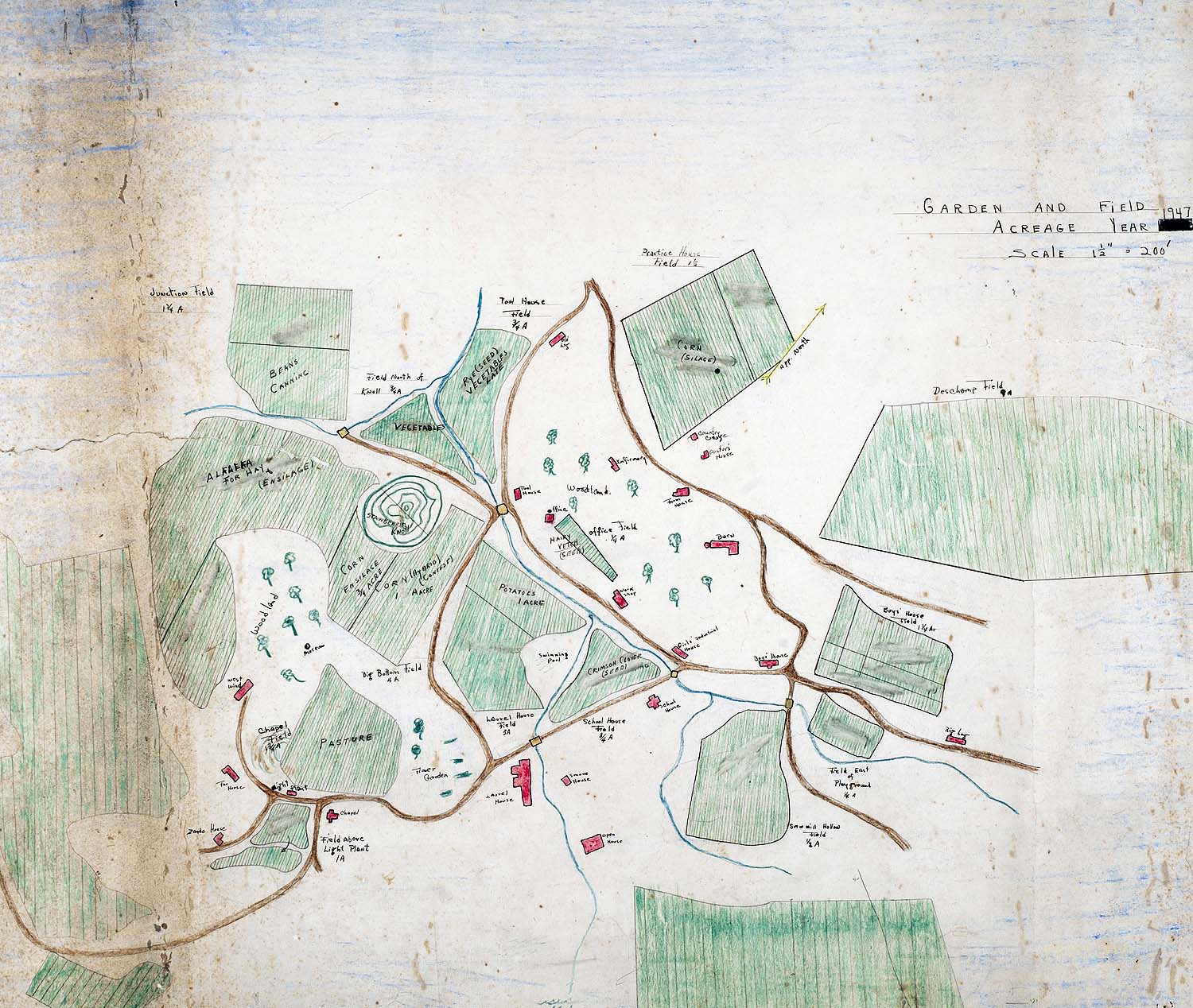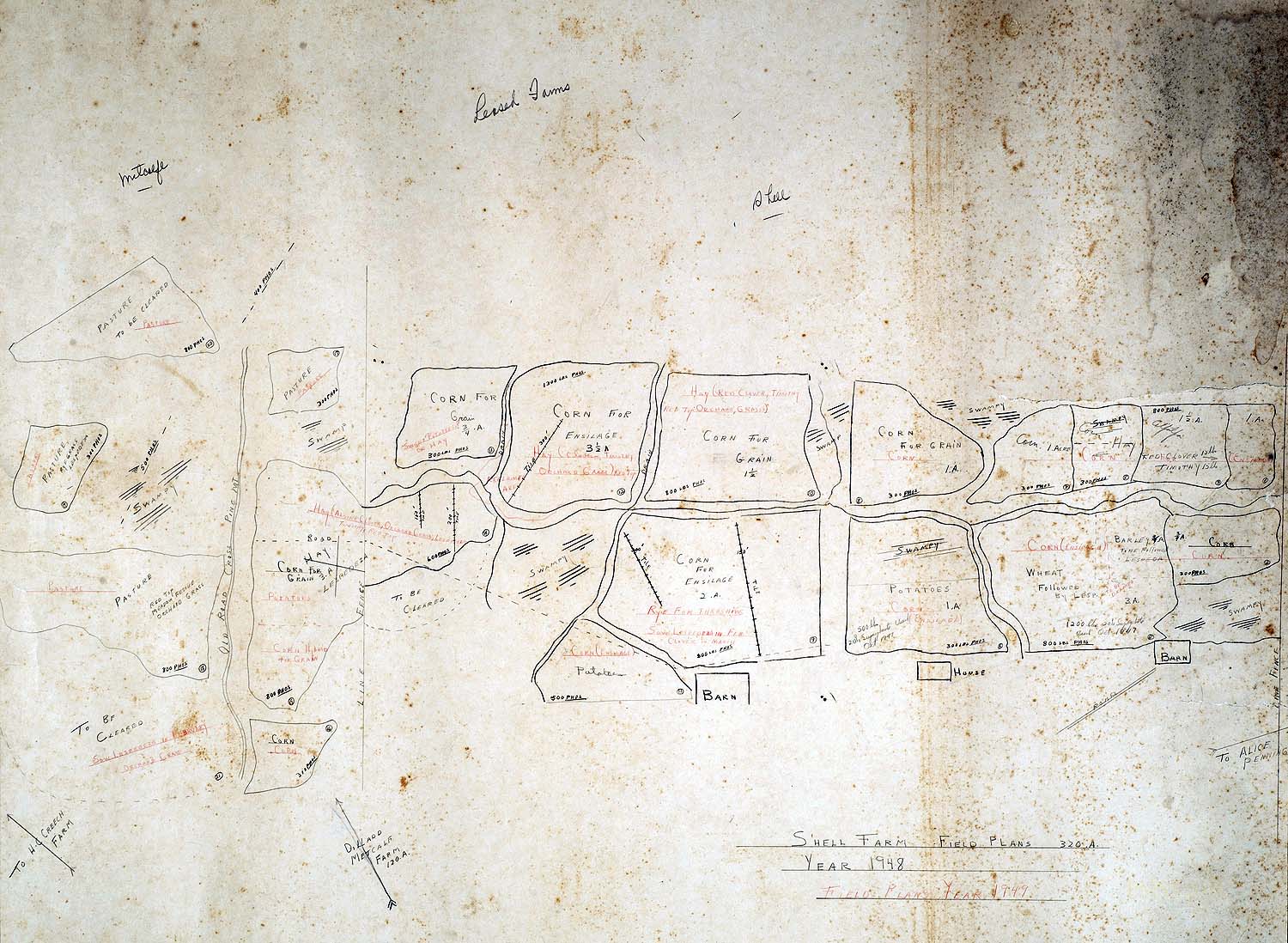Pine Mountain Settlement School
Series 11: FARM and FARMING
Drawings 1947 & 1948
By William Hayes, PMSS Farmer
History of decline
GARDEN AND FIELD 1947 DRAWING

Farm and Garden Drawing by William Hayes, 1947. [MSR5277_1.jpg]
SHELL FARM 1948 FIELD PLAN

Shell Farm, Field Plans, 1948, 1949. [320 A] Map by William Hayes. [MSR5865_1.jpg]
TAGS: Farm, drawings, garden plots, fields, mapping, Wells Early History, farms, farming, agriculture, Pine Mountain Settlement School farm, Harlan County Kentucky, Horace McSwain, Leon Deschamps, Katherine Pettit, Evelyn K. Wells, cover-crops, ditching, soil analysis, Luigi Zande, Mr. Browning, Mr. Baugh, terrace gardening
FARM Planning and Drawings
The FARM at Pine Mountain has a long history of planning. It is part of the agricultural cycle to plan for crops. Mapping is part of that planning process. The most extensive farming was conducted during the early years of the School when the process of preparing the land was the most intense and the demands for produce from the farm were at their most critical. The productivity of the farm in its early years often dictated how well the institution would fare economically. The economic health of the institution when it was a Boarding School was especially dependent on good planning and good harvests.
The FARM program has always been included in the functions of the School for most of its existence. Today, the School still has a Farm Manager, but the focus has shifted mainly to garden produce and does not include livestock. Nor does it support a resident student and staff population. The economics of planning have changed and maps are rarely drawn today. The farm, however, remains within the core programming at the School.
FARM DRAWINGS
While few drawings have survived from the earlier years, the two detailed drawings above, completed in 1945 and 1947 by William Hayes, the Farm Manager during the 1940s, give a good overview of the amount of land that was placed under cultivation by the School during the Boarding School era.
Land cultivation takes labor and at the end of the Boarding School years, the forest began the slow process of reclaiming the land, and programs began to adapt to the changing national, regional, and local demands and trends of farming. Pastures that once supported students and staff, became Environmental Education exploration sites, agriculture became “gardening,” and was relegated to only a fraction of the acreage used in earlier years and was the product of staff, specific program needs, or, seed experimentation.
The following reflections captured in Evelyn Wells’ History of PMSS 1913- pages, observes some of the difficult dances made by farmer and their fields.
EVELYN WELLS REFLECTIONS ON THE FARM
Evelyn Wells, in her notes for a History of the School, left the following early record of the FARM:
The farm, under the continuous supervision of [co-director] Miss [Katherine] Pettit, has been developed by Mr. Baugh (l913), Mr. [Horace] McSwain, (1915) Mr. [Luigi] Zande (1916) Mr. William] Browning (assisting Mr. Zande 1921. Full charge 1923).
After some experimenting with the raising of corn it was found to be a too expensive [a] crop for us, and the chief effort has gone into developing, by ditching and draining and building up a sour, heavy soil with cover crops, a garden which little by little has spread over our bottomland until in June 1928 its produce was worth some $3200. Our garden land had a sorry reputation among local farmers when the school began, but by dint of thousands of feet of ditching and draining and a long rotation of crops it has been built up from an unproductive swamp and the kitchen is extremely dependent upon it …
For the first two years nothing could be done but ditching and fencing and soil reclamation. It was of no immediate good to the school table for some years. But in 1917 Mrs. Zande writes of having helped can 1200 half-gallon cans of our own vegetables. It is fortunate that the garden began to yield as the war came on and food became a grave consideration. While we were experimenting with raising corn and hay, the Wilder farm and the Medcalf farm on Little Laurel were cultivated for those crops….
During Mr. Zande’s regime, the work of ditching and replacing old ditches went on, the creeks were straightened to give a handful more of tillable land here and there, the boulders that one met all through the garden were blasted out, more land was cleared, and the timber used in construction, instead of being burned according to the usage of the country; and at the end of that time, there were about 75 acres of farm and garden….
During the period that Mr. Browning has had charge, the garden, acreage has practically doubled, and the work of early years has borne fruit in Mr. Browning’s wonderful garden crops. The policy of sowing cover and legume crops and turning them under as an equivalent for manure has continued….
The increase in garden truck is shown by the fact that in 1923 we had 48 bushels of tomatoes from the garden, and in 1928 118 bushels. As against the 400 cabbages we raised in 1923, we think of the 9000 in 1927, of which those sold in the neighborhood and to the lumber camps alone after the family grants were supplied, were worth $125.00.
While Pine Mountain has always fallen far short of being a model farm for the neighborhood, it has taught valuable lessons, such as terrace gardening, virtually unknown here until people saw the school hillsides terraced, the rotation of crops, and the turning under of legume crops. In the past three years, in particular, neighbors have begun raising soybeans and cowpeas for hay…
MORRIS YEARS AND BOARDING SCHOOL CLOSURE
In later years Pine Mountain Settlement School’s farm continued to provide much of the produce needed in the dining room of the institution but also experimented with other farm ventures. The farm under the direction of Glyn Morris from 1931 until 1941, was particularly experimental. During the Morris years, the dairy herd of Ayrshire milk cows was a model for the community and also provided a revenue stream for the institution in milk sales. It was a unique experiment within the rural settlement movement.
Unfortunately, by 1950 following the closure of the Boarding School, it was clear that the farm could not sustain its labor-intensive dairy and farming activities. See the extensive farming in 1947-48, above). With no Boarding School labor to support the enormous efforts needed to make farming productive, the large agricultural system failed to thrive and was given a negative review by the Board of Trustees following a study conducted by Berea faculty member and Economist, Fu LiangChang “Whither Pine Mountain?”, the large-scale farming operation ceased to exist. Chang, who explored the financial road forward and the looming changes in agriculture across the nation, recommended the closure of the farm operations, dairy herd, and poultry houses that ceased to compete with growing commercial suppliers.
The Boarding School closed in 1949 and only staff and community hires remained to keep the garden-farm active. Activity on the farm was significantly reduced as plans were made for the departure of the School’s farmer and farming staff with only one individual remaining — Brit Wilder, to see the reduced program through the next few years. Brit had been an integral part of maintaining relationships with the community at large and also staying true to the initial farming initiatives of Katherine Pettit, the founder. In many ways, he was the force behind the long stability of the farming initiatives at the School. After farmer, William Hayes departed following ten years as lead farmer, Brit and later, Matthew Boggs continued to carry many smaller farm initiatives forward and to help with the integration of “farming” and with the growing interest in the growing Environmental Education program.
See:
FARM and FARMING
FARM Guide
ENVIRONMENTAL EDUCATION
See Also:
BARN
FARM HOUSE
MILK HOUSE
FARM Report 1940
FARM Shell Farm Field Plan 1948
WELLS RECORD of Pine Mountain Settlement School Guide
FARM Wells Record 08 Dairy Poultry
DANCING IN THE CABBAGE PATCH VI – POULTRY
DANCING IN THE CABBAGE PATCH IV Farming the Land Early Years 1913-1930
DANCING IN THE CABBAGE PATCH Farm and Dairy I Early Years
DANCING IN THE CABBAGE PATCH – Farm and Dairy II Morris Years

